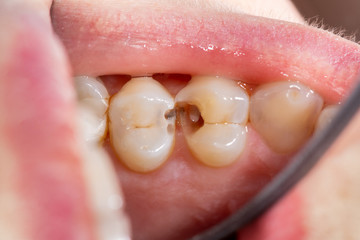Latest Update
 15 Jul 2020
15 Jul 2020 Which filling should I choose for my tooth?
Which filling should I choose for my tooth?
This is not an uncommon question which most of us have to answer when we visit a dentist.
With dentistry evolving at such a high pace and with so many technological advances in dentistry, we have more and more options available now.
Although it is hard to explain all the differences between the different materials available, we can touch base on three main materials available to make the choice easy for you.
Amalgam
Amalgam (silver-coloured) dental fillings have been around for a very long time. It was first invented by English chemist Bell in 1819. Later on, it had some changes with mixing of other metals.
Amalgam is made up of a metal alloy of mercury, silver, tin and copper. It is mixed as a soft filling material that is placed into a prepared tooth and hardens over a short period of time.
It is a very reliable and durable material that was used for many years for dental fillings due to its success in a moist environment. However, due to its un-aesthetic nature with the dark colour, its use of mercury and some doubts in relation to release of mercury has led a quest to find an alternative filling material.
Although a lot of people have reservations about its release of mercury and effects on general health, it is not proven yet.
Composite
Another very popular material is composite which has almost replaced amalgam and is widely used at present.
It is made up of glass particles mixed with an acrylic resin. It comes in different viscosities, each chosen by the dentist for different reasons.
It is used as soft material then hardened with help of light. It is chosen due to the following benefits:
- Availability of multiples colour shades so the material can be matched to the tooth.
- Increased working time for the clinician to manipulate the material to suit the tooth structure
- Mercury-free
- Composite resins are able to bond, or stick, to the tooth, which can lead to less tooth removal during preparation
- Easy to use for small and simple repairs and restorations
It is not as hard as amalgam and has issues with longevity in large cavities due to wear, chipping margins, porosity and shrinkage. This leads us to another material; ceramic or porcelain.
Porcelain/Ceramic
In terms of terminology, porcelain fillings are often called inlays, onlays, ceramic or CEREC restorations whereas Composite or resin restorations are referred to as plastic white fillings. Composite Resin is placed in soft and set hard with the curing light, which leads to its shrinkage whereas the porcelain restoration is a hard prefabricated filling that is bonded into the cavity. When a filling is on the larger side, requiring corners or cusp replacements, composite restoration does not last long and porcelain has more longevity due to its lack of shrinkage, hardness and wear resistance and it is recommended to have porcelain reconstruction of the tooth to ensure that you are not back in the dental chair fixing the same tooth again any time soon.
The porcelain filling is no doubt more expensive, but when you consider you may have to replace a plastic resin filling over and over, the cost differential may prove to be a lot less than first envisaged.
- More longevity, wear resistance and durability.
- Better bonding to the tooth.
- Highly aesthetic result giving natural appearance.
- No shrinkage of filling material.
- Tooth-like transparency and smooth texture; ceramic is the closest we can get to natural tooth enamel.
- Excellent for large fillings, amalgam replacement, broken and cracked teeth.
- More cost effective long-term.
After a thorough check-up and diagnosis, your dentist will discuss which of these materials is best suited to you. The decision will be based upon your oral health and what material will be best suited to the type of work needed, both for restoration’s optimum function and appearance.
